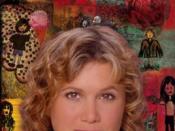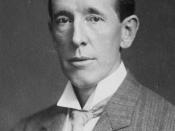The Obsession with Weight in the Entertainment Industry.
Have you ever looked at the cover of YM, People, or Cosmopolitan and seen a model at or above their ideal weight? At the same glance, have you ever seen even the slightest blemish in their skin? Did u know that Marilyn Monroe wore a size 12? In today's entertainment industry, the emphasis seems to be on being "thin". It is amazing how in such a short amount of time we can go from the "silicon and curves" era to this "skin and bones" era that we are in today. This obsession with weight has gotten extremely out of hand. It has driven women to eating disorders such as bulimia and anorexia, attempted suicide, and death from both. The truth is that most of these models aren't "perfect" or "blemish free". Photographers can alter photo images and models are even airbrushed to cover up any imperfections.
The few that are truly under weight are unhealthy. Some can't even control their eating any longer. This is what the public does not see. The public does not see the struggles that these models are going through trying to stay skinny. Many are near death and some have lost their lives.
Remember Tracey Gold from "Growing Pains"? She almost lost her life to anorexia. The stars' battle with weight is not an easy one and it leads the public to believe that it is healthy and a good way to lose weight. Women that are too skinny are at just as big of a disadvantage as women who are severely obese. The obsession with weight is a serious issue in the United States and we can contribute it to the media. If the magazines are looking for a "thin" model, then the models that need jobs are going to try to achieve that acceptable weight. This is where we are going wrong. The entertainment industry feeds on the "thinness" of models and celebrities, yet alters their true identity before it reaches the public through hair, makeup, and computer technology. If the media told the readers that "fat was in", there would be a complete change in weight and eating behaviors. We would have more of the average-sized women on the covers of our magazines and on the sets of movies. Who says that the media should be the one to decide on the image that the "perfect" woman should have? It is nearly impossible to get away from the "skinny" images because they are everywhere: models, magazine covers, movies, television shows, etc. But what we do not realize is that it "can take as many as ten people to make the model look good" (www.missclick.chickclick.com). Want to know why the outfit can fit the model so perfectly, but when someone tries it on it doesn't fit quite the same? Well, according to Andrea, ChickClick managing editor and former employee at a teen magazine, the clothes only fit the models that well because their boobs were taped up and in and the clothes were pulled snug against the body and secured with tape and pins. Then, what they couldn't fix by hand, they fixed on the computers.
Why can't I get my hair to do that? Three words: professional hair stylists. "It took hours for the stylist to do the model's hair, and then the magazine would describe how to do it in four easy steps" (www.missclick.chickclick.com). When it comes to flawless skin, "if u had two people painting your face with makeup and were then photographed in special lighting by a talented photographer", you would look flawless too. Not only do they perfect your clothes and your skin in person, but they have a professional artist who picks out the best photo and then fixes any flaws on the computer (www.missclick.chickclick.com). What we as the public have to realize is that although the majority of these girls are skinny, none of them are perfect. Every one of them has flaws just as the average woman does. We have to stop comparing ourselves to them because no one, including the models, can ever be flawless.
Magali Amadei is the first top female model to speak publicly about her personal seven-year battle with bulimia. She's joined the American Anorexia Bulimia Association in educating young people about the dangers of our culture's narrow beauty ideal, and the ways that it contributes to widespread eating-disordered behavior. At first, Claire Mysko, the administrative director of the American Anorexia Bulimia Association, did not know if she wanted a beautiful model to represent her organization, but then she realized that it would relay an important message to the public. That message was that beauty does not equal happiness for Amadei (www.abcnews.com). This is a big step because so many women believe that if you are thin and beautiful, then you are automatically happy. These people's negative attitudes towards and preoccupation with food and weight are unhealthy. It is only the beginning of a long battle with weight obsession.
Naomi Wolfe, in her book The Beauty Myth, suggested that "the beauty myth in this society is not about whose body is fat, it is about whose body is wrong-- and that for women, being fat somehow exemplifies her body's "wrongness", in deep ways" (www.queensu.ca). The entire advertising industry is built on using the female body to sell everything from home appliances to perfumes and cars. Advertising and the media today permeate our understanding and valuing of our own bodies. If the media emphasized obese models and movie stars, would that not change our perception of weight and our own self images? Although the media does not want to take blame for this, we have to blame them more than the models because they are the ones that feed on this weight issue. The models are just looking for a job, and if the industry wanted average sized or overweight models, then most of the models would try to gain weight.
It is sad to imagine that most young people have never seen a world that doesn't hate fat. In Losing It: America's Obsession with Weight and the Industry that Feeds On It, Laura Fraser recalled that "a hundred years ago, a beautiful woman had plump cheeks and arms, and she wore a corset and even a bustle to emphasize her full, substantial hips. Women were sexy if they were heavy (Fraser, 16). Not only was weight seen as a sign that you could afford to eat well, but it also showed that you could fight off infectious diseases. Between the 1880's and 1920's, that pleasant image of weight thoroughly changed in the United States. Fat was seen as a major health risk, but according to Woods Hutchinson, a medical professor, fat is "really a harmless, healthful, innocent tissue" (Fraser, 16). By 1926, Hutchinson did not only have to defend fat against the readers of Cosmopolitan, but also against the fashion industry.
The fashion industry apparently had the backing of insurance agencies, food reformers, grave physicians, and physical trainers in chanting that the new commandment of fashion would be "thou shalt be thin" (Fraser, 17). This is what brought about young girls trying to lose their "roundness". Hutchinson also noticed that at the end of the nineteenth century, science was also helping to shape the new slender ideal with the calculation of calories, weight in pounds on a scale, and the calculation of "ideal" weight. As the twentieth century got underway, advertisers learned early to offer women an unattainable dream of thinness and beauty in order to sell more products. What they didn't know was that women would try as hard as they could and some even to their deaths to reach this "unattainable dream of thinness". A cultural obsession with weight relied on countless factors that included economic status symbols, morality, medicine, modernity, consumerism, and changing women's roles (Fraser, 20).
Thinness is an American preoccupation. Although Europeans admire slenderness, they have more relaxed and moderate attitudes about food, eating, and body size. In countries where there isn't an abundance of food and where women are still performing traditional roles, "plumpness" is still admired. Even the countries whose women worship "thinness", only do it because they want to look like the women in the American ads (Fraser, 20). By 1930, American women knew how very important it was to be "thin". In the words of Cosmopolitan, "How decisively even ten or fifteen extra pounds detract from one's appearance and make the most expensive gown dowdy! A youthful, slender figure means everything today." From this moment on, even though there were times when voluptuousness was still admired as with Marilyn Monroe, American women could never be too thin.





